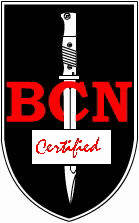| Pictures (click to enlarge) |
Type | Description | Blade Length |
Overall Length |
Muzzle |
Markings | |||
| in. | mm. | in. | mm. | in. | mm. | ||||
  |
M1880 | Yataghan sword bayonet for use with the 10.15 mm. Serbian Model 1880 (Mauser-Milovanović) rifle.
Serbian Army Major, Kosta "Koka" Milovanović, modified an updated version of the single-shot Mauser M871 rifle, the M1871/78, to improve ballistic performance. He adopted the Norwegian 10.15 mm. cartridge developed for the Jarmann rifle and changed the rifling so that the lands became narrower as they approached the muzzle. Designated Serbian Model 1880, Serbia procured at least 100,000 rifles with bayonets from Mauser 1881–84. The contract also included over 125,000 spare parts. Mauser procured the M1880 yataghan bayonets from Gebruder Weyersberg. Most are marked on the ricasso. These were made with two domed rivets securing the crosspiece. The scabbard is wood covered in black leather with an iron top mount and lower finial. This example appears to have been refurbished. It is unmarked and no longer has the domed crosspiece rivets. It mounts to the Mauser M1871, so was definitely made for the Serbian M1880 rifle. 43,000 M1880 rifles were converted into repeating rifles chambered for the 7 x 57 mm. cartridge 1908–11 at the Military Technical Plant in Kragujevac (VTZ). The conversion was based on a design by Col. Gojko Đurič. Many surviving M1880 bayonets were altered for use with the M1880/07 rifle. The blade was shortened to 10-in. (250 mm.), the adjustment screw removed from the muzzle ring, and muzzle ring diameter reduced to 16 mm. New steel scabbards were made for the M1880/07 bayonets. M1880/07 (Mauser-Đurič) rifles saw service during the First World War and remained in Serbian military service until 1937. |
18.6375 | 470 | 23.7625 | 605 | .690 | 17.5 | None. |
  |
M1899 |
Knife bayonet for use with the 7 mm. M1899, M1899/07, and M1910 Mauser rifles.
According to noted Yugoslavian weapons expert Branko Bogdanovic, M1899 bayonets were made: —1899–1906 by Simpson & Co. of Suhl, Germany; Plumb’s bayonets made for Serbia were marked with "Plumb" and the year of mfr. on the ricasso. However, additional bayonets were made in 1915 by Plumb for commercial sale, using the leftover parts from the Serbian contract. The absence of any markings identifies this example as probably a contract overrun piece that Plumb made for commercial sale. The Serbian M1899 bayonet is one of the few double-edged Mauser bayonets. The grips are secured by high-domed rivets, with washers. The crosspiece is also secured by high-domed rivets. The metal on this example was blued, although many are found in the white. The Serbian M1899 rifles were almost identical to the Chilean M1895 Mauser rifle, which was chambered for the 7 x 57 mm. cartridge. Serbia went for this design, because DWM already had the production line in operation and could begin delivering rifles right away. That's how the Serbs ended up using the 7 mm. cartridge, which was not at all the norm on the European Continent. |
9.75 |
248 | 14.375 |
365 | .615 |
15.6 | None. |
| Back | Next | ||||||||
| Return to Bayonet Identification Guide Index | |||||||||
| © Ralph E. Cobb 2010 All Rights Reserved | Top | ||||||||



